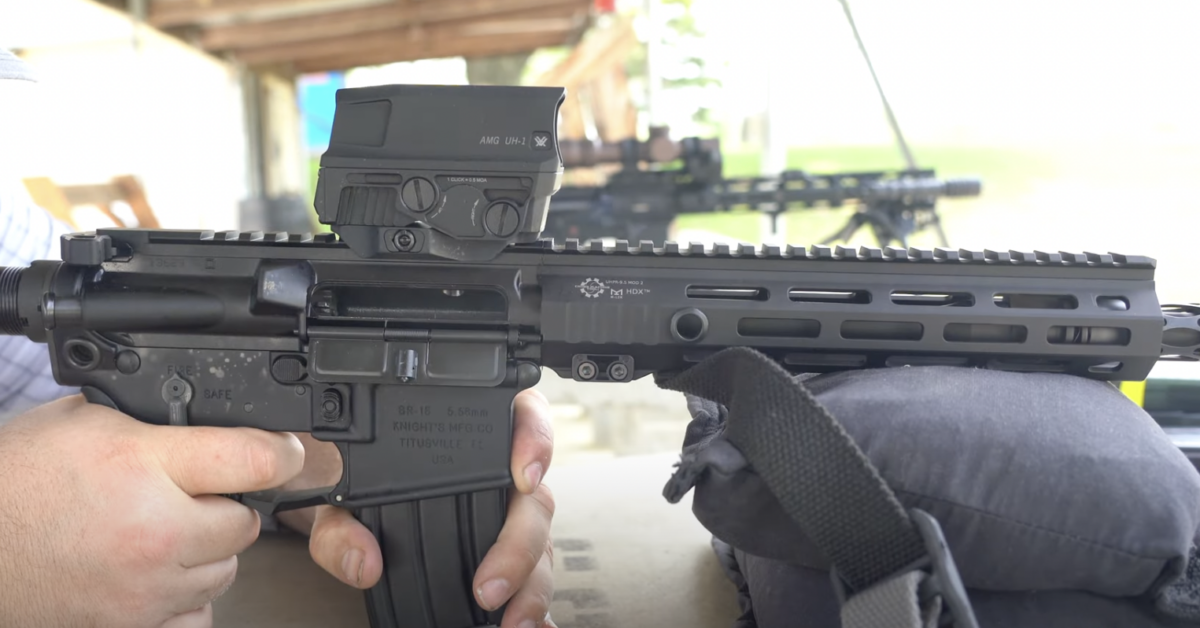EXECUTIVE SUMMARY: “High-end” rifle works flawlessly, runs like a sewing machine, eats everything, but ejects rounds at 0130-0200 regardless of gas block setting. Is this a problem? Or who cares as long as it runs perfectly otherwise?
THE WHOLE NINE YARDS:
So… took an all-factory Noveske N4 G3 rifle and made it better, faster, stronger.
Put on Form-1 SBR.
Removed factory 13.7” with P/W Flaming Pig, replaced with 14.5” Proof CF “Wylde” coupled with the new JP D2 52-position (!!!) adjustable gas block.
Replaced 15” NSR3 rail with 13.5” NSR3 rail.
Replaced all lower parts with $400 in V7 Titanium bits — ‘cuz everyone needs an $80 safety selector and $100 ejection port cover.
Replaced buffer tube with V7 Lithium Aluminum tube, ‘cuz why not?
Replaced factory trigger with SSA-X.
Replaced Noveske BCG with JP Chromed LMOS.
Replaced Noveske buffer with JP SCS.
Cerakoted entire rifle in Gen2 HIR-265 (IR signature-reducing coating for NODs fun) — upper, lower, handrail, buffer tube, shiny bits like door cover and takedown pins, etc.
Added HUX flash hider and 7.62 Ti (pre-Flow) can.
Popped an FDE ATACR 1-8 with offset RMR-06 in C1 mount on top and called it a day.
Will take pics soon for posterity.
Anyhoo… with all that said, we finished the rifle on the Thursday before I took it to CR2’s Light Fighter course the very next day. First order of business was to get the gas system perfectly adjusted. The HUX can doesn’t have much backpressure at all, and the gun will never really be shot unsuppressed, but we did try it both with and without — zero difference.
JP’s new D2 AGBs have 52 positions for adjustment. Their instructions say to close it off entirely, then back-out 12 clicks, or roughly one full turn, and start there. They say the gun probably will NOT cycle at 12 clicks, and they were correct. They say to adjust in 3-click increments, which we did. After the first adjustment (15-clicks), the gun ejected, but just barely at about 0100. Went another 3 clicks and it was better, about 0130-0200. At this point I figured additional adjustment would push angle of eject toward the Orthodox Religious Dogma-Approved 0300-0400 angle, but no matter how may clicks we dialed-in, the pattern didn’t change — again, with or without the can.
Given this behavior, I figured the best position was at 18-21 clicks, since it cycled just fine with everything from cheap 223 Wolf Gold as well as 855A1 and 262 Mod 1C and the much maligned AAC 77g OTM 556.
Took it to the 3-day LF course the very next day and it never gave the slightest hiccup all weekend, nailing IPSC steel at >650 yards like a Rock Star.
Shoots like Chantilly Whipped Cream — soft and smooth.
But that eject angle…
Assume it’s more related to the LMOS/SCS than the gas system?
Aside from the angle, is there any reason to mess with it? It’s just absolute perfection otherwise and I hesitate to pfutz with it by playing Rifle Jenga.
THE WHOLE NINE YARDS:
So… took an all-factory Noveske N4 G3 rifle and made it better, faster, stronger.
Put on Form-1 SBR.
Removed factory 13.7” with P/W Flaming Pig, replaced with 14.5” Proof CF “Wylde” coupled with the new JP D2 52-position (!!!) adjustable gas block.
Replaced 15” NSR3 rail with 13.5” NSR3 rail.
Replaced all lower parts with $400 in V7 Titanium bits — ‘cuz everyone needs an $80 safety selector and $100 ejection port cover.
Replaced buffer tube with V7 Lithium Aluminum tube, ‘cuz why not?
Replaced factory trigger with SSA-X.
Replaced Noveske BCG with JP Chromed LMOS.
Replaced Noveske buffer with JP SCS.
Cerakoted entire rifle in Gen2 HIR-265 (IR signature-reducing coating for NODs fun) — upper, lower, handrail, buffer tube, shiny bits like door cover and takedown pins, etc.
Added HUX flash hider and 7.62 Ti (pre-Flow) can.
Popped an FDE ATACR 1-8 with offset RMR-06 in C1 mount on top and called it a day.
Will take pics soon for posterity.
Anyhoo… with all that said, we finished the rifle on the Thursday before I took it to CR2’s Light Fighter course the very next day. First order of business was to get the gas system perfectly adjusted. The HUX can doesn’t have much backpressure at all, and the gun will never really be shot unsuppressed, but we did try it both with and without — zero difference.
JP’s new D2 AGBs have 52 positions for adjustment. Their instructions say to close it off entirely, then back-out 12 clicks, or roughly one full turn, and start there. They say the gun probably will NOT cycle at 12 clicks, and they were correct. They say to adjust in 3-click increments, which we did. After the first adjustment (15-clicks), the gun ejected, but just barely at about 0100. Went another 3 clicks and it was better, about 0130-0200. At this point I figured additional adjustment would push angle of eject toward the Orthodox Religious Dogma-Approved 0300-0400 angle, but no matter how may clicks we dialed-in, the pattern didn’t change — again, with or without the can.
Given this behavior, I figured the best position was at 18-21 clicks, since it cycled just fine with everything from cheap 223 Wolf Gold as well as 855A1 and 262 Mod 1C and the much maligned AAC 77g OTM 556.
Took it to the 3-day LF course the very next day and it never gave the slightest hiccup all weekend, nailing IPSC steel at >650 yards like a Rock Star.
Shoots like Chantilly Whipped Cream — soft and smooth.
But that eject angle…
Assume it’s more related to the LMOS/SCS than the gas system?
Aside from the angle, is there any reason to mess with it? It’s just absolute perfection otherwise and I hesitate to pfutz with it by playing Rifle Jenga.
Last edited:

